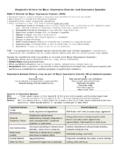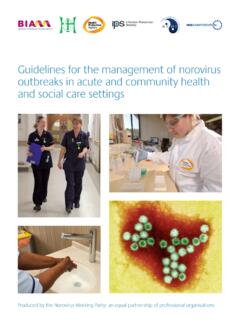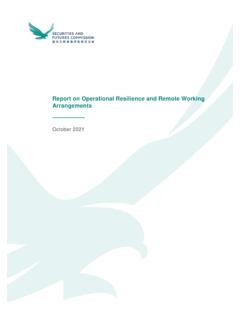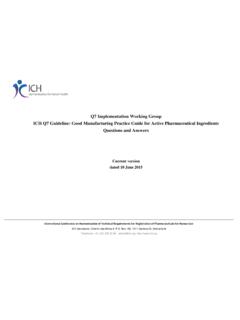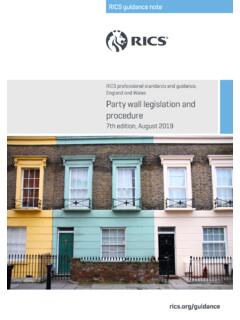Transcription of How to Lead Collective Impact Working Groups
1 How to Lead Collective Impact Working GroupsDANIELA URIBE, CARINA WENDEL, VALERIE BOCKSTETTEA Comprehensive ToolkitAbout FSGFSG is a mission-driven consulting firm supporting leaders in creating large-scale, lasting social change. Through strategy, evaluation, and research we help many types of actors individually and collectively make progress against the world s toughest teams work across all sectors by partnering with leading foundations, businesses, nonprofits, and governments in every region of the globe. We seek to reimagine social change by identifying ways to maximize the Impact of existing resources, amplifying the work of others to help advance knowledge and practice, and inspiring change agents around the world to achieve greater part of our nonprofit mission, FSG also directly supports learning communities, such as the Collective Impact Forum, Impact Hiring Initiative, and Shared Value Initiative, to provide the tools and relationships that change agents need to be more about FSG at Introduction: The Critical Role of Working Groups and Their Co-Chairs5 Module 1: How To Build Membership8 Module 2.
2 How To Plan for and Run an Effective Meeting11 Module 3: How To Build a Culture of Collaboration14 Module 4: How To Put Systems Thinking into Practice17 Module 5: How To Engage with Community Members20 Module 6: How To Be Data-Driven and Learn along the Way Appendices23 Appendix A: Sample Working group Stategies24 Appendix B: Meeting Planning Steps for Co-Chairs25 Appendix C: Meeting Agenda Template26 Appendix D: Meeting Follow-up Email Template Working Group27 Appendix E: Meeting Follow-up Email Template Steering CommitteeHOW TO LEAD Collective Impact Working Groups | i WHY A KIT FOR Working group CO-CHAIRS?
3 As illustrated in Figure 1 below, Working Groups are the heartbeat of Collective Impact : where action occurs and goals are brought to life. These Groups (also called work Groups , task forces, community action networks, strategy teams, and a variety of other names) are where practi-tioners come together to contribute their time, expertise, passions, and lived experiences to help develop and implement strategies. Much has been written about the role of Backbone staff in fostering Collective Impact . However, we know that one of the reasons Backbones can be leanly staffed is that they rely on select Working group members who go the extra mile and volunteer to be Working group co-chairs.
4 Over the years we have seen how critical these co-chairs are to the success of Collective Impact , and yet, not much has been written about or explicitly for these important figures. Thus, this kit is dedicated to these co-chairs because without them Collective Impact would not be developed this kit for a Collective Impact initiative funded by the Hampton Roads Com-munity Foundation in Virginia. We are grateful it has encouraged us to share this resource. Moreover, while we created this kit specifically for Working group co-chairs, the contents may also be helpful for Backbone staff, Working group members, and co-chairs of any form of 1.
5 TYPiCAL Collective Impact STRUCTURES11 Adapted from Listening to the Stars: The Constellation Model of Collaborative Social Change by Tonya Surman and Mark Surman, ACTIONSTRATEGIC GUIDANCE= community partner ( , nonprofit, funder, business, public agency, resident)BACKBONE SUPPORT Guide strategy Support aligned activities Establish shared measurement Cultivate community engagement and ownership Advance policy Mobilize resourcesSteeringCommitteeWorking GroupWorking GroupWorking GroupWorking GroupChairChairChairChairChairChairChair ChairCommon Agenda and Shared Metrics| FSG2 THE CRITICAL ROLE OF Working Groups AND THEIR CO-CHAIRSWORKING Groups AT A GLANCEWHO?
6 15 to 25 people2 who represent key aspects of the system the Working group is focused onHOW? Facilitated by Backbone staff and Working group co-chairsWHAT? Meet regularly3 to drive implementation by engaging in 3 ACTiViTiES over time: 1. Determining the SCOPE of the Working group , grounded in data on the local situation ( , historical context, assets, and needs) and local or national best practices2. Developing STRATEGIES (see Appendix A for samples), which may include the following: Better understanding the current situation: aligning or overlaying existing data sets or systems with one another Learning by trial: identifying an opportunity to start small with willing partners, learn from the experience, and then expand or replicate Increasing coordination: finding ways to realign existing programs, protocols, and stake-holders to work together differently to maximize efficacy Enhancing services.
7 Adopting a previously unnoticed proven practice from inside or outside the community to enhance existing services or programs Identifying policy-change opportunities: looking for opportunities at local or state levels and relaying these to a Steering Committee and/or a policy and advocacy Working Group3. Driving the IMPLEMENTATION of the strategies by: Identifying resources ( , community leaders, funding) required to put ideas into action Inspiring change in their own organizations and networks in accordance with the strate-gies Determining how to measure the Working group s progress and success Providing updates to Steering Committee and community and responding to feedback2 Enough people to represent the whole system, but not so many that meetings become We recommend monthly meetings to ensure sustained momentum and TO LEAD Collective Impact Working Groups | 3 ROLES OF Working group CO-CHAIRSW orking Groups typically have 2 to 3 co-chairs.
8 Ideally one of whom also serves on the Steering Committee, playing the following roles: Contributing to the development of the agenda and content for each Working group meeting including serving as thought partners to Backbone staff and help-ing contribute content expertise Facilitating discussions and decision making in meetings including speaking up if conversation gets stuck, encouraging multiple perspectives, and reporting out on smaller group discussions Contributing to Working group member management including addressing member concerns outside of meetings or learning more about members roles and experiences to help inform strategies Nurturing relationships among Working group members including ensuring each member s unique assets and contributions are supported and valued Cultivating a focus on equity including seeking diverse membership, fostering conditions for everyone to be included, engaging in community.
9 And using data to understand disparities and develop strategies Serving as a bridge for the initiative s work in the community including seeking input from key stakeholders, speaking at community events, and updating commu-nity members on progress| FSG4 Working Groups are called Working Groups for a reason. Just as the Steering Com-mittee is tasked with steering the direction of the initiative, Working Groups are responsible for the work that will drive the Impact of the initiative. Finding effective people to fill the role of Working group members (including the co-chairs) may be the first big step to achieving Impact down the road.
10 Collective Impact initiatives create opportunities for many people to be involved through various Groups and levels of engagement; Working group participation is one such opportunity. Being part of a Working group may create new leadership oppor-tunities for staff or community members, which can be energizing. Here are some helpful characteristics for identifying Working group members:4 Reducing disparities in outcomes experienced by key populations may mean focusing on race in some contexts and socio-economic dynamics in others, as well as considering issues of immigration status, sexual identity, language, disability, THIS MATTERSHOW TO APPROACH ITCHARACTERiSTiCS OF ALL MEMBERS (15 to 25 members)ADDiTiONAL CHARACTERiSTiCS FOR CO-CHAiRS (Typically 2 to 3 co-chairs) Have firsthand experience with the issue ( , members of the community, frontline staff of organizations Working on the issue)
